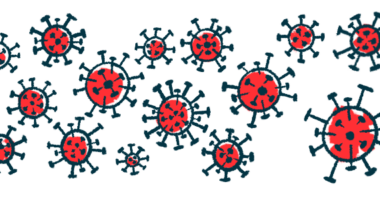Lung Scarring Blunts Ability to Fight Infections, Mouse Study Suggests

Fibrosis or scarring in the lungs may blunt the ability of the body’s immune cells to fight off an infection in idiopathic pulmonary fibrosis (IPF), a study in mice found.
Researchers observed that when isolated from a fibrotic lung, macrophages — a type of white blood cells that engulfs and destroys potentially harmful substances or organisms, such as bacteria — were no longer able to kill methicillin-resistant Staphylococcus aureus (MRSA), a type of bacteria that is commonly found in the lungs of people with IPF.
In addition, neutrophils — another type of white blood cells that travels to sites of infection, where it engulfs bacteria and releases compounds to kill them — lost the ability to reach the lungs and release bacteria-killing compounds.
“A lot of people have looked at how macrophages and neutrophils contribute to fibrosis, but nobody has turned the question around and asked how fibrosis impacts the ability of macrophages and neutrophils to fight off infection,” Bethany Moore, PhD, who is the study’s senior author, said in a university press release. “That’s where the power of this study is.” Moore chairs the Department of Microbiology and Immunology at the University of Michigan Medical School.
The study, “Fibrotic lung disease inhibits innate immune responses to Staphylococcal pneumonia via impaired neutrophil and macrophage function,” was published in JCI Insight.
In IPF, scar tissue forms in the lungs for an unknown reason, making these organs more prone to bacterial infections. Such infections may make people with the disease more likely to have worse symptoms or die sooner. However, the link between fibrosis and infection is unclear.
To know more, Moore’s team looked at how fibrosis may affect the way the immune system responds to an infection. They used a mouse model in which fibrosis is induced by delivering bleomycin, an anti-cancer medication, directly into the lungs. To serve as controls, a group of mice received a saline solution instead of bleomycin. Then, animals were either infected with MRSA or left uninfected.
Like humans, fibrotic mice infected with MRSA had an increased rate of death. They lost weight and, after one week, only 65% of them remained alive. In contrast, all control mice were alive at that time point.
Next, researchers watched for changes in the animals’ ability to fight off bacteria. They found that fibrotic mice performed worse than nonfibrotic mice at clearing MRSA from the lungs.
“It is well-known that clearance of MRSA is largely dictated by innate immune cells, particularly neutrophils and macrophages,” said Helen Warheit-Niemi, the study’s first author. “We reasoned that, since we are seeing impaired clearance in fibrotic mice, it might be due to defects in the immune response caused by fibrosis.”
To understand if the immune response could be impaired, researchers looked at which genes were turned “on” and “off’” in the lungs of fibrotic mice. They found differences in the expression, or activity, of 27 genes between fibrotic and nonfibrotic mice. Many of those genes were involved in the process of regulating inflammation and immune response against an infection.
“These findings point to a broad impairment in immune responses to bacterial lung infections after fibrosis,” the researchers wrote.
When researchers isolated macrophages and neutrophils from the lungs of fibrotic mice, they found their ability to kill bacteria was reduced. This was also true for neutrophils isolated from the bone marrow, a spongy tissue in the center of bones that contains stem cells, which can give rise to various types of blood cells.
“My hypothesis is that a signal from the fibrotic lung is making its way to the bone marrow and affecting the cells that are developing and maturing there,” Warheit-Niemi said. “If we could identify this signal, we could develop a therapeutic strategy to block it and keep the immune cells of IPF patients in better shape to fight off infections.”
According to researchers, these findings suggest a possible mechanism for why people with IPF are at greater risk of contracting infections and the complications they may cause.
“Down the road, if an IPF patient is admitted to the hospital with an infection, our results might help build a framework for how to best treat them,” Warheit-Niemi said.








